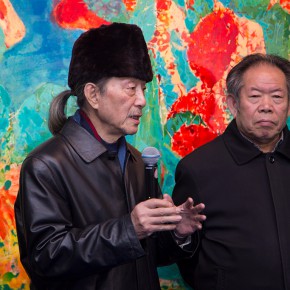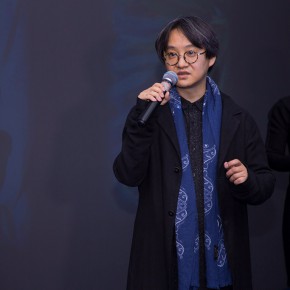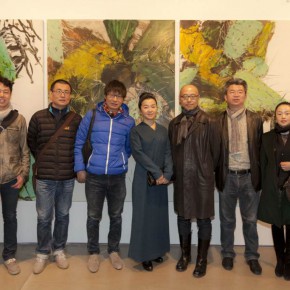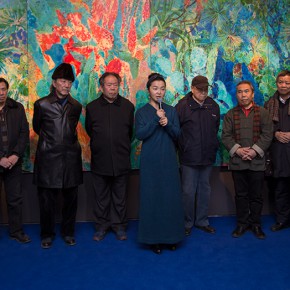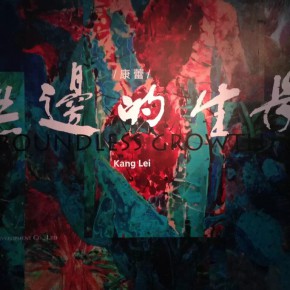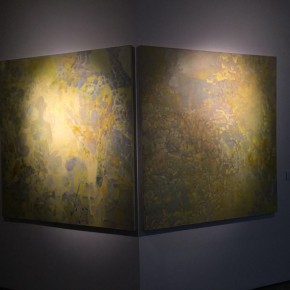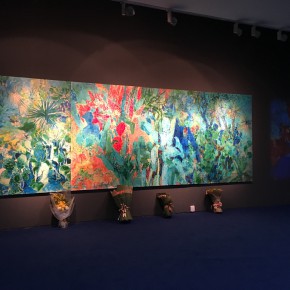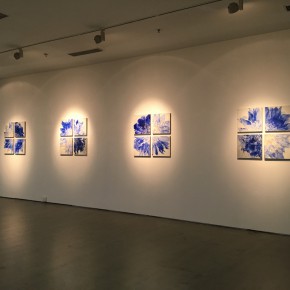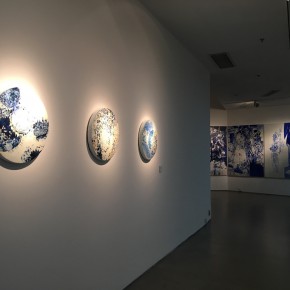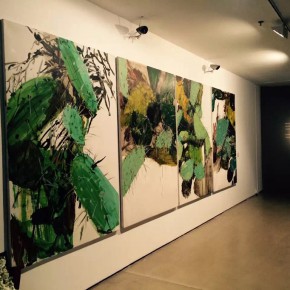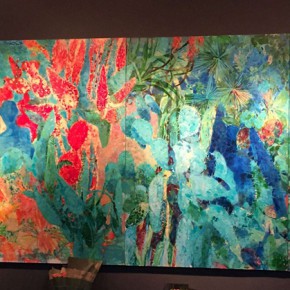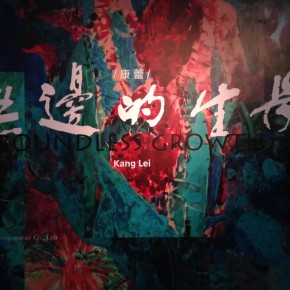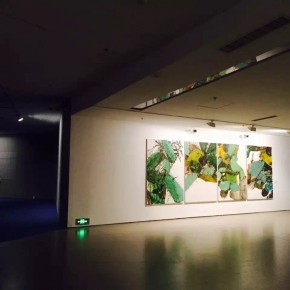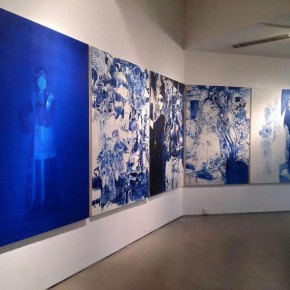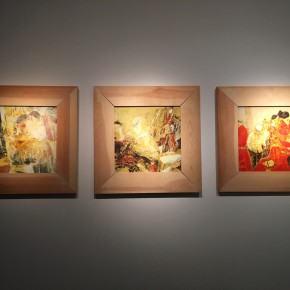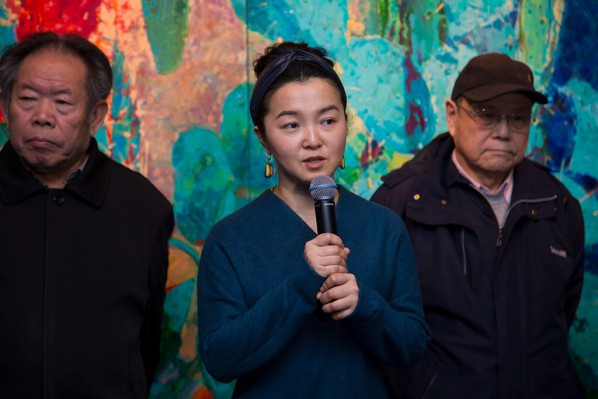
Curiosity and true temperament are the born weapons of artists, challenging the boundary and boundlessly growing, I refuse to give myself a fixed limit, but hope to have the unlimited vitality and creativity.
– Kang Lei
On March 6, 2016, Boundless Growth–Exhibition of Kang Lei’s Works kicked off at Today Art Museum. Kang Lei who works in the Department of Oil Painting, CAFA, has a good nature and pleasant companions and the opening ceremony of her works exhibition attracted numerous people, including many senior teachers of CAFA and artist colleagues, and also attracted large numbers of art lovers, students and the media to attend the opening. As the 3rd solo exhibition of Kang Lei’s artistic career, it contains the recent feelings of life, the world, art and the self of the artist.
The exhibition is curated by Vice President of the Beijing Fine Art Academy, Director of Art Museum of Beijing Fine Art Academy Wu Hongliang. He stressed that “Boundless Growth” was an exhibition to express her individual thoughts and growing segments of the artist Kang Lei. This title was presented by the artist herself, and was finally decided upon after repeated discussions with the curator. “Boundless Growth” is not only a description of the state, a narrative form, but also an inner vision of Kang Lei. Borrowing the artist’s own words, “It is a world that is easy to be identified, because the creation of people is increasingly being labelled. Even if one wants to be an artist, the specialty seems to be the most free and unrestrained, it is impossible to avoid being defined and classified. The artists themselves are also unknowingly placed in such a definition and framework. But curiosity and true temperament are the? weapons of artists, challenging the boundaries and boundlessly growing, I refuse to give myself a fixed limit, but hope to have the unlimited vitality and creativity.”
Entering the exhibition, what is first seen is her most recently created huge work “Paradise 2016, Growth”, it is together with another huge work “Paradise 2016, Stabbing Pain” to constitute the main work of the show. On?both sides of the work “Paradise 2016, Growth”, it specifically sets up the projection with details of two works, so that it is a flashback, shaking, crisscrossed and fused images, together with the original ones form delightful reflections. More than dozens of other works have been displayed on 2/F Exhibition Hall of Building No.2 in Today Art Museum, to show the outline of the whole creative context of Kang Lei in the past more than 10 years, starting from the early Tajik people to traditional Chinese opera characters, and then to the “Blue and White” series, “Sunflower” series, “Paradise” series and so on.
It is respectful but it also emphasizes the new experiments in painting, where we can clearly tease out two key elements from her recent creations: Firstly, the trial of the language and form of painting, the artist always hopes to fuse the Western painting techniques and Oriental painting implications. Under the condition that she has fully researched the Oriental and Western painting languages, she hopes “to breakthrough boundaries and limitations of language. Study and use of the representations of Chinese traditional elements transcend the expression of traditional means. The use of traditional Chinese ink painting, mural painting and other folk factors transforms the language of painting, fusing the writing, blank areas and breathability of Chinese painting and calligraphy”. It features a large number of works of tempera, that the artist had contact with from ancient western painting material in 2007, and she used the classic tempera skill to draw a self-portrait at the beginning, and then she tried to combine the western classical painting style of multilayer dyeing and the traditional Chinese ink painting, after many years of practice and improvement, her use of tempera is not a classical form any more now, but becomes an expressive way to help her freely apply the thickness of oil painting, the transparence of Chinese ink painting and the motley of mural painting.
Secondly, it is the artist’s creative concept of the “distance”. In the artist’s life and creation, “distance” is a changing concept, and also the main aspect of her artistic creation and thinking. In Kang Lei’s opinion, there is a distance between art and life, thought and expression, tradition and modern, representation and abstract, and these distances have dialectical swapping relationships. Distance is pure and true, both selective and fascinating. In the words of the curator Wu Hongliang, “She is addicted to the use of effective means to explore variables of distance in the creation, to explore the artistic meanings in between the two poles of the “close” and “departure”, and the exploration of artistic language is one of the meanings.
Kang Lei specifically created two large-scale new works for the exhibition. Among, the 5.6-meter-long and 2-meter-high “Paradise 2016, Growth” describes the fullness of the jungle, interlaced with various plants, to reveal the different characters. In a blue-green block, even red cacti appear. Kang Lei said it is her creation. It is the distant beauty between reality and art that passes between the truth and lies. In another newly created painting “Paradise 2016, Stabbing Pain”, we can see the symptom of her trying to break through: Different from her conventional heavy and complicated composition, this painting takes a pure white canvas color as the background of the work, intending to draw lessons from the spatial arrangement approach that reckons that a blank page as inked in the traditional Chinese painting. There are obvious stroke traces in the cacti foliage, and uses the technique of writing to germinate the thorns of leaves. The work presents the unceasing “pervasive” creative state of the artist.
When Kang Lei was interviewed by CAFA ART INFO, she said that, “hope to break through various frames, edges and boundaries of the heart… At the same time, I refuse to be positioned in a certain subject, a certain style and genre in artistic creation, and I need my own expressive language.” Kang Lei thought that, the changes of techniques and materials meant the changes of the language form. The change of subject is reflected in the change of concept, but remains essentially the same despite all the apparent change, and the self-subject is consciously or unconsciously reflected on the chosen object, sometimes appearing and sometime disappearing, which are all the self-growth projections, and her expression is based on the self-attention during the different periods to present day. When she was questioned that, a large number of plants appearedin the painting, starting from the early sunflowers in different flowering phases, to the presently exhibited new paradise series focusing on “cactus”, did she care about the enlightenment brought by plants themselves? Kang Lei said yes and said she has drawn sunflowers because she preferred the simple state of sunflowers growing naturally in the earth, and she is able to experience the effects of wind and rain, rather than the little flowers guarded in the greenhouse, confined to a delicate and beautiful small space. She has drawn cacti because she was very interested in this plant, which is beautiful but full of thorns, just like the growth of any life is more or less stinging. She prefers cactus that is inner firm and tenacious. She has drawn paradise actually revealing her feelings of society and the world, reflecting her focus and thought on social life in many aspects. Rather than directly drawing real life, Kang Lei gets used to blend the attention into the metaphor of work. She painted the paradise because it was the world faced by her life, which was gorgeous, thriving, and hidden anxiety, beauty, temptation, entanglement, desire, and even fear is embedded, but it is the real ecological world, it will never lack vitality. Paradise “Alaksana” means “All images are fabricated”.
Through this exhibition, the artist Kang Lei expresses the inner desire and creative state of “refusing solidifying herself, and constantly seeking a breakthrough”, so that, “Boundless Growth” is an exhibition that reflects Kang Lei developing her artistic boundaries, a dialogue in the infiltration, a nuanced description growing up in the germinal process.
The exhibition continues to March 21.
Text by Zhu Li/CAFA ART INFO, Photo by the artist
Translated by Chen Peihua and edited by Sue/CAFA ART INFO


